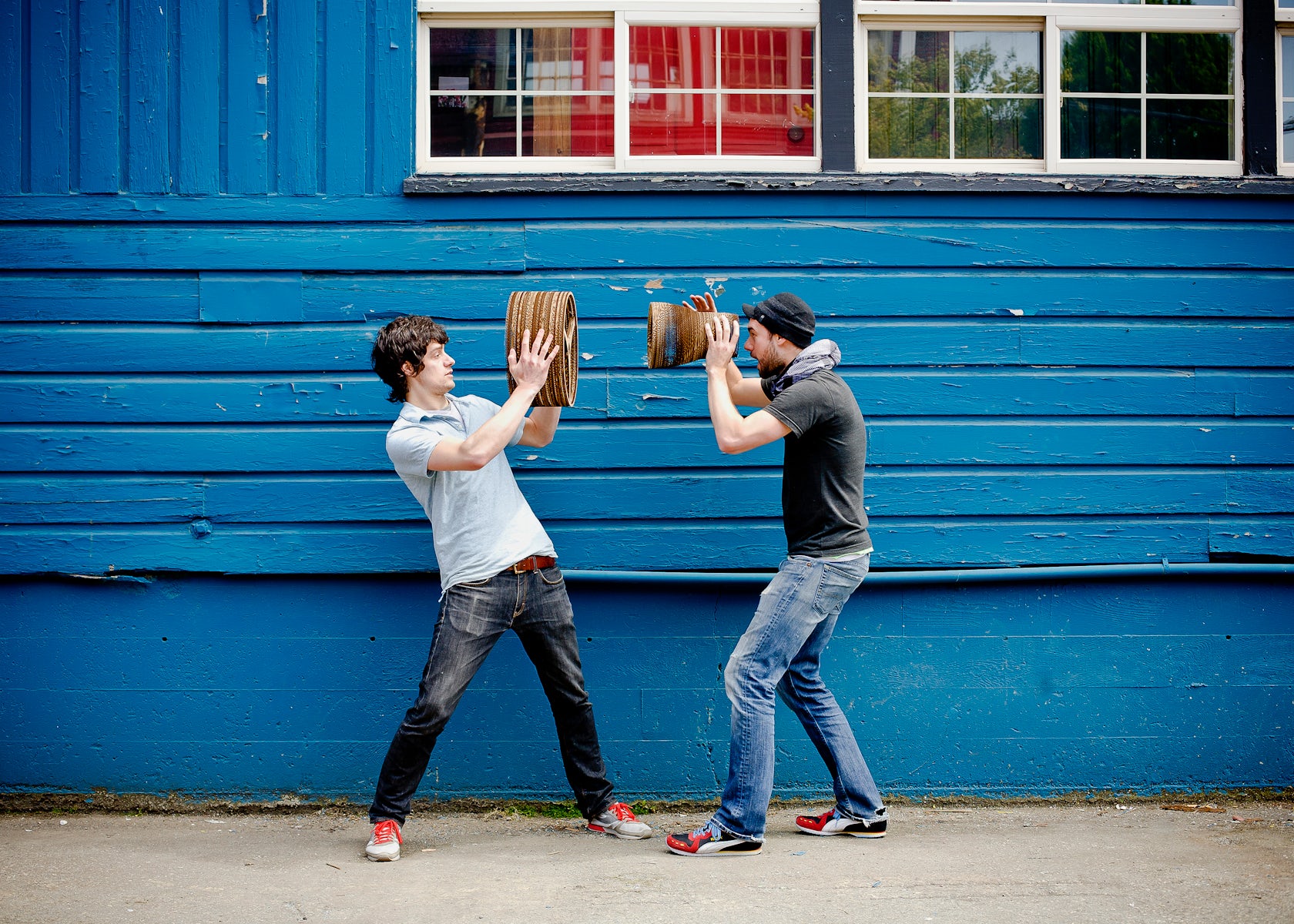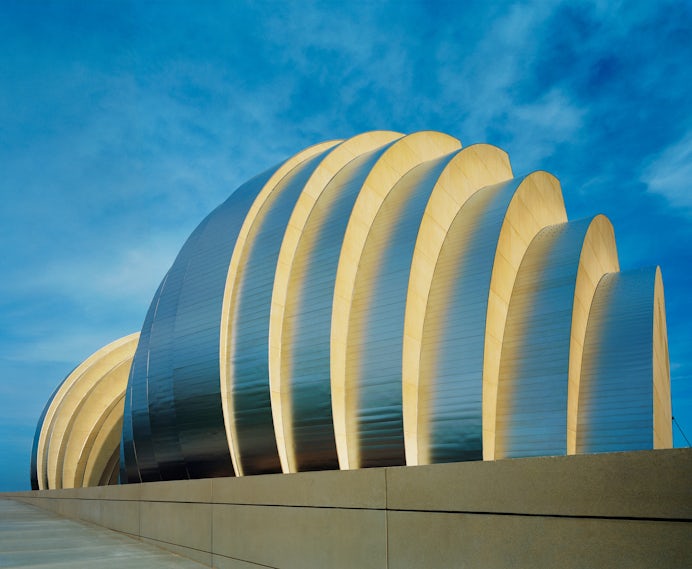“When life gives you lemons, make lemonade.” Or, in this case, products. Practice as an architect long enough, and you’ll feel the impacts of changing economies for better or for worse. For two young architects, a lack of work opportunities during the Recession led to their foray into products, which turned out to be a blessing in disguise. Today, Seth Grizzle and Jonathan Junker, founders of Seattle-based Graypants, continue to design products, to great success, as well as buildings. In fact, other architects and interior designers have a particular fondness for what’s considered their flagship product: the Scraplights series of layered, recycled cardboard pendants.

© Lindsay Borden
Jonathan Junker and Seth Grizzle, founders of Graypants
Graypants (humorously named because Junker and Grizzle met as college roommates wearing the same exact pair of gray pants) has since developed an impressive repertoire of other lighting products, a few furniture pieces and decorative objects and, of course, architectural projects for which they’ve won accolades including an AIA Seattle Honor Award. Grizzle shares with us his thoughts on product design, the connection between products and architecture and his studio’s very first built project, which garnered multiple awards including the aforementioned AIA honor.

From left: Scraplights Classic and Scraplights Custom
How did your bestselling Scraplights come about?
Seth Grizzle: We got accepted into a gallery competition for sustainable seating, so we produced a series of chairs made from discarded or found materials — old newspapers, scraps of plywood, slip sheets from freight containers and cardboard. But the gallery space had really, really tall ceilings so the chairs ended up looking like doll furniture. To lower the scale of the room, we made lights and hung them above the chairs, and that’s how the lights were born.

Tilt Lamp
How do your and Jonathan’s architectural backgrounds inform product designs?
SG: They relate to each other in different ways. It’s mostly a matter of scale: Architecture is a lot larger, but you still need to focus on the details, and by focusing on and appreciating them, you can apply that sensitivity to smaller objects and really hone in. It’s a quicker turnaround than a building, but it still requires a lot of work and attention to things that some people may not notice, things that make up the entire product.
We learn something from designing a product that we can apply to architecture, and then we learn something from architecture that we apply to the products. They kind of feed off of each other.

From left: Scraplights White and Tilt Lamp
Why do architects get interested in product design in the first place?
SG: There’s always a need or desire for something custom, something unique within a space, and I think that personally spiked our curiosity. We realized we could make such things. We could have fun with those things and kind of take it a step further.

From left: Loci and Murmurations

Kerflights
So what’s the “gateway product” for architects to get into product design?
SG: I think seating is a big one. Seating and lighting are both things that are needed readily within the space, and it definitely piques curiosities of a lot of architectural designers to have something that enhances the space with a similar language.

Slice Chair
What are some of your non-cardboard lighting products?
SG: We have our Steplights, which are aluminum, and Kerflights, which are wood. We’ve done some custom cloud installations made from pingpong balls.
Pingpong balls?!
SG: Airbnb and Gensler wanted this big cloud in this five-story atrium of the Airbnb headquarters in San Francisco, so we ended up coming up with the design for that and thought that pingpong balls make for an interesting material to diffuse light and have this texture. We made one about 12 feet by 7 feet by 4 feet using 30,000 balls.

Steplights

Steplights
Cool. You’ve done furniture and objects, too, including an Ice Press. How did you come up with that idea?
SG: I got fascinated with it. I had seen it before, and the ones I’d seen were kind of ugly and the details weren’t thought through. They’re quite large for what they are and really heavy. I thought if you are going to have one of these, it should look beautiful sitting on the counter. One thing led to the next, and we designed it.

From left: Scraplights Classic and Murmurations
I watched the video of this and couldn’t help but wonder: Who has been an influence on you guys?
SG: I like to say I’m a blend of Dr. Seuss and the Eameses. We love the Eames’ aesthetic and the whimsy of Dr. Seuss’s childlike thinking, I suppose. The Eameses had that playful tendency, as well. As far as architecture goes, I like Stephen Holl and Peter Zumthor. I think Zumthor’s absolutely amazing.
What advice do you have for other architects aspiring to design products?
SG: Realize that your design or architecture degree is applicable to a lot of different things. I think it’s a degree in problem solving at the end of the day. You’re solving spatial problems. You’re solving all sorts of types of problems, and you can take that same knowledge and apply it to things outside of buildings. And pay attention to what you really like about architecture, and you can make things that enhance that space, as well. Understand that there are unlimited possibilities of what you can do with a design degree if you really are curious about it.
Project-wise, your first built one is the award-winning Garage. What is that space?
SG: There was an existing house with a detached garage that was kind of standard 50s construction. It had been forgotten and just used to store stuff and dilapidated a bit. The clients didn’t want it to be just a guesthouse and kind of gave us free reign so we were really fortunate and got to explore. What we came up with was a space that could do everything and nothing, a theater to watch things unfold around it.

Garage
Tell us about the materials and program.
SG: There’s a new glass box on a steel structural frame. We salvaged fir from the rest of the existing structure and milled them into floors, walls and operable bed panels. The beams were reclaimed from a building in Seattle. The whole building opens on three sides so, on a nice summer day, it can feel like you’re outside. You enter the space through this speakeasy front door that is also a bookshelf, bar and desk. We hid two beds in the floor, which you can open up. We’re kind of celebrating little ideas and finding unique ways to save space.

Garage
Did you specify any products for the Garage?
SG: We used a big Fleetwood sliding door and Corian, but we mostly custom-designed and fabricated everything, including the lighting and all the glass.

Garage
Are you working on any other projects?
SG: We’re working on one currently. We have an NDA on it, though.
What about products?
SG: It’s mostly the lighting. But we’re working with a friend of ours from the company Urbancase on contract furniture. They’re these beautiful wooden workstations. We’re working on ceiling systems and surfaces, too. We’re trying to take this to the next level and do an interesting ceiling system with integrated lighting and acoustics. And we’re still thinking of making our own gray pants at some point, which would be funny and appropriate.




